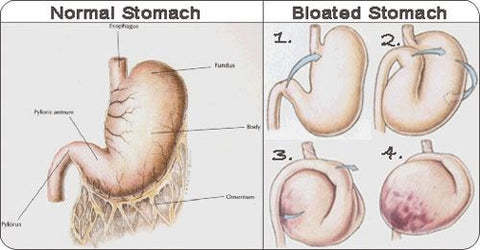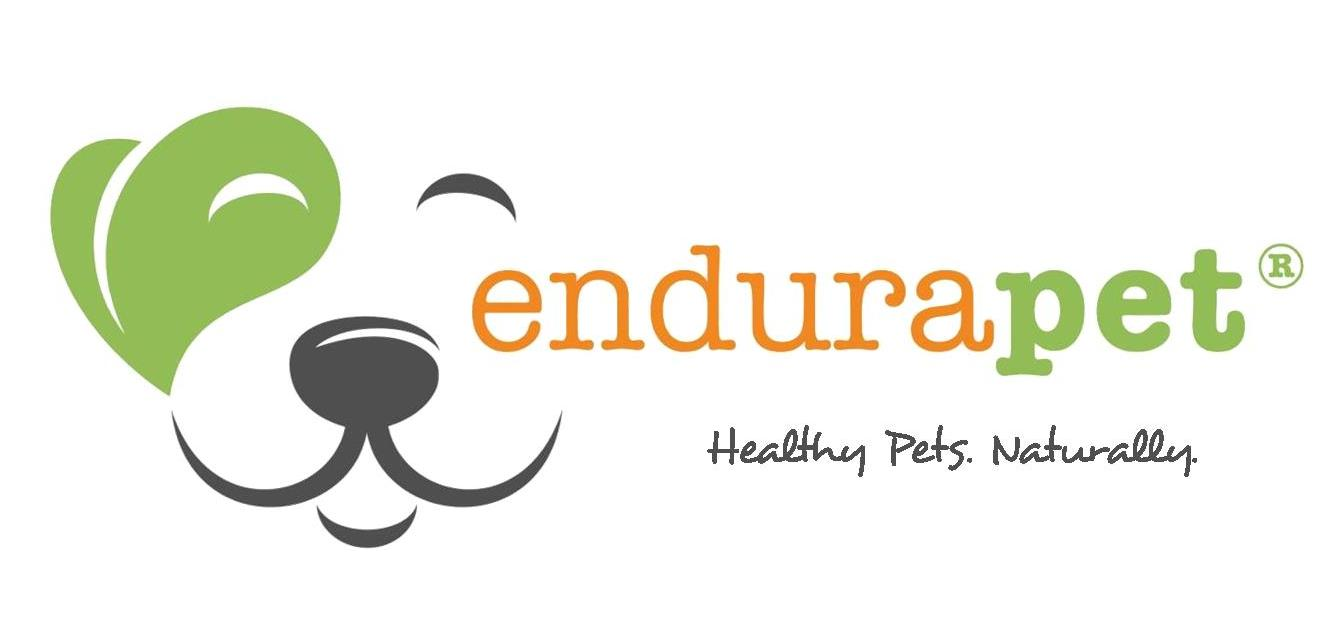Bloat, sometimes referred to as “torsion”, or “GDV” is something we hope your dog never experiences. Ever. For those who have had a canine friend or companion affected by bloat, our hearts go out to you and your dog. Devastating and heart wrenching to observe, bloat is thought to be one of the most excruciating experiences for a dog to endure, and sadly, often results in death. We hope the following information can help prevent any of our readers’ dogs from ever having to experience this painful condition.
Hopefully, you will never need this information, but EVERYONE RESPONSIBLE FOR A DOG MUST know these facts about 'Bloat'!
What is 'Bloat'?
Definition:
'Bloat' is often used as a blanket term to describe separate but often related conditions. Gastric Dilatation is an uncomfortable disorder in which the stomach becomes distended from excessive gasses and fluids. Torsion is a possible complication, involving a twisting of the stomach. Volvulus is a Torsion greater than 180 degrees, a very serious condition. These conditions are collectively known as Gastric Dilation - Volvulus, or GDV. The exact causes of GDV are unknown.

A very simplified analogy to these complicated anatomical difficulties is to imagine the dog's stomach as an oblong party balloon. Like a balloon, the stomach is also able to contract and expand, but there are limits to the pressure that each can endure. A dog undergoing a mild gastric dilation is experiencing a condition similar to a slightly overinflated balloon; not ideal, but most often a burp (or release of pressure from, you know, further down the trail...) remedies this imbalance. The stomach of a dog diagnosed with volvulus is more like a 'balloon sculpture'; it is twisted at both ends, and this torsion, along with the air pressure trapped within, causes it to remain fixed in this abnormal and potentially fatal condition. Gastric Dilatation does not always cause volvulus, and there are various complications associated with GDV which may or may not be present.

Effects of Bloat
One of the most dangerous aspects of bloat is its often rapid onset. In the early stages, bloat causes:
- Prevention of adequate blood return to the heart from the abdomen
- Loss of blood flow to the lining of the stomach and intestinal tract
- Pressure on the diaphragm preventing the lungs from adequately expanding
If untreated, the following conditions may shortly occur:
- Extreme pain
- Tissue death (necrosis)
- Heart arrhythmia
- Rupture of the stomach wall (causing blood loss, possible sepsis)
- Distended spleen
- Fatality
Risk Factors of Bloat
Predisposition
- Anatomy; a greater chest depth to width ratio indicates an increased risk of bloat (breeds such as Great Danes, St. Bernards, Dobermans, and others)
- Heredity; dogs having family members who have had Bloat seem especially susceptible
- Advancing Age; risk increases with age, but all ages are at risk
External Influence
- Stress; changes to routines, a new dog in the home, etc.
- Gulping for Air; eating/drinking too rapidly, elevated food bowls
- Improper Diet; gas-producing foods, excessive carbohydrates, and/or fats
- Activity Before and After Feeding; exercise and vigorous activity prior, but especially after, eating
Symptoms of Bloat:
First Observable Signs
These are often expressions of anxiety, restlessness, and disinterest, and may include unusual behaviors like whining, pacing, turning to look at their own abdomen, or 'licking at air.' As discomfort increases, panting may be evident, possibly becoming 'heavier' and more rapid. Drooling, or foam around the lips, may occur. Some dogs may seek out a favored spot as a comfort, or to hide. One of the most common reactions, a 'hallmark' symptom of Bloat, are repeated, usually unproductive, attempts to vomit, which may reoccur every few minutes, often accompanied by a retching or 'coughing' sound. Many dogs react by unusual positioning, becoming 'hunched' appears to be a frequently observed reaction. While some dogs will curl up or crouch, others will refuse to lie down or sit, or stand awkwardly, splaying their legs. Distension of the abdomen may not be visible in all cases.
Further Examination
If Bloat is suspected, it is advisable to investigate further. Does the abdomen feel as though stretched tight? Can normal digestive sounds be heard if your ear is pressed against the dog's side? Check the gums; they may flush bright red in the beginning, becoming pale or bluish with lack of circulation. An accelerated heartbeat may be noticed. General weakness may lead to collapse. Note that any particular case of bloat may present several of the symptoms described here, or may only present a few. Only a veterinary professional can diagnose GDV, and quick action is essential.
OF NOTE: Always keep copies of your veterinarian and emergency/24-hr veterinarian information – phone numbers, directions, paperwork - in an easily accessible place, in case of emergency. Both electronic and paper copies are recommended. Searching for this information in an emergency will only add to your stress, and take valuable time.
Treatment of Bloat:
Diagnostics - What to expect
In most situations, veterinarians will recommend:
- initial blood work; a complete blood count (CBC), serum chemistry, and urinalysis will allow the veterinarian to rule out other disorders which may cause symptoms which are similar to GDV
- abdominal x-rays, to confirm diagnosis
- an electrocardiogram (ECG), to detect cardiac arrhythmia
-blood gas analysis, to determine extent of respiratory difficulties
Additional tests may also be necessary, particularly in preparation for surgery.
Stabilization and Decompression
Only licensed veterinary professionals should attempt to treat GDV. The longer the condition persists, the worse each of the effects described above become. Intravenous fluids are administered, possibly oxygen, to stabilize the patient. A stomach tube and lavage may alleviate the pressure, though some cases require surgery for decompression, involving anesthesia and placement of a needle or catheter into the stomach cavity.
Surgery
Once stabilized, a procedure called Gastropexy should be performed. The abdomen is explored, damage assessed, and the stomach is counter-rotated and surgically tacked into proper position. In worse cases, necrotic tissue from the stomach and spleen may need to be removed and repaired. The risk of a recurrence of bloat without a gastropexy is 76%, with a 24% mortality rate, recurrence after gastropexy is 6%. Additional information on the procedure can be found here.
Reducing Risk of Bloat
Although there is no definitive means to prevent bloat, the following tips may aid in reducing the risk:
Feeding Regimen
- Feed scheduled meals, do not allow access throughout the day, when you are not available to observe
- Smaller Meals, Feed two or three smaller servings per day, rather than less frequent, larger servings.
- Slower Eating, possibly using a 'food puzzle' toy, or a food bowl specially designed to encourage slower eating
- Calm Time; avoid stress factors, and exercise/vigorous play for one hour before feeding, and for two hours following feeding.
- Avoid raised feeding bowls. Current wisdom indicates that raised feeding bowls may increase the risk of bloat.
- Avoid excessive drinking in one session by monitoring. Do not leave your dog without access to water, but also attempt to limit intake for an hour or so, before and after feedings. This will help minimize dilution of the gastric juices, and allow more efficient digestion and less gas production.
A Better Diet (more here)
- Do not feed dry food exclusively
- Avoid foods high in carbohydrates and fats, look for greater proportions of protein (30+%), and a minimum of 3% crude fiber
- Avoid gas-producing foods such as soy, brewer's yeast, alfalfa, beans, etc.
- Maintain appropriate weight, as determined by your veterinarian
Work with your Veterinarian
If your dog has several risk factors, you may want to discuss the use of preventative medicines with your veterinarian, such as intestinal anti-flatulence medication.
Non-prescription anti-gas medicines containing Simethicone may also be recommended, to treat symptoms of gas as they occur. Always check with your veterinarian before administering any medication, over-the-counter, or otherwise!
If you have an at-risk dog, you may consider having a prophylactic (preventative) gastropexy performed in conjunction with spaying or neutering, or as a separate procedure. As with any treatment, the relevant factors must be assessed by your veterinarian.
SOURCES and LINKS
http://pets.webmd.com/dogs/gastric-volvulus-bloat-dogs-life-threatening-emergency
http://www.globalspan.net/bloat.htm
http://www.aspca.org/pet-care/dog-care/bloat
https://www.acvs.org/small-animal/gastric-dilatation-volvulus
http://www.youtube.com/watch?v=Bm9U-16ldqo
